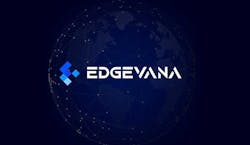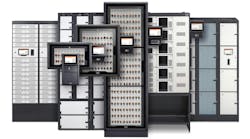Edgevana Looks to Speed Growth for Web3 Blockchain Infrastructure
What will Web3 infrastructure look like? While some describe Web3 as a decentralized replacement for today’s leading content platforms, early indications are that much of Web3 will use cloud services or bare metal servers housed in data centers, rather than blockchain nodes running on desktop computers around the world.
This is creating business for cloud platforms and some data center operators, as well as new providers specializing in blockchain infrastructure.
That includes Edgevana, which is helping blockchain businesses create distributed networks of nodes that provide security and process transactions. Edgevana has just launched QuickRamp, a service to help build these networks quickly, deploying nodes across many locations and data center providers. Blockchain nodes serve as the building blocks for digital currencies and distributed applications.
“By reducing time, complexity, and cost, we’ve shown we can make becoming a node operator far more attractive,” said Mark Thiele, co-founder and CEO of Edgevana. “The effort to build a globally distributed network of data centers and nodes can require interaction with dozens of vendors. Our goal for QuickRamp is to deliver more value, faster and at lower cost while strengthening node operator communities and blockchain ecosystems.”
As its name suggests, Edgevana was founded with a focus on accelerating the deployment of edge computing, which brings data closer to users to speed content delivery. That mission has evolved into specialized services for the fast-growing blockchain sector, which includes digital currencies like Bitcoin and Ethereum, but also applications built atop blockchains that aim to integrate content and commerce in new ways – broadly known as Web3. These include NFTs (non-fungible tokens), DeFi (decentralized finance), DAOs (distributed autonomous organizations), and blockchain-powered games.
“The original goal for Edgevana was abstracting resources for the edge, and trying to make it easier for folks who wanted to execute quickly,” said Thiele, who founded Edgevana in 2019 with fellow industry veteran Subhan Jahromi. “We thought it was an amazing opportunity in the Web 2 space, and now there’s an opportunity in blockchain and the Web3 space.”
The Role of Nodes in Blockchain Infrastructure
To understand Edgevana’s new focus, as well as the broader future of blockchain infrastructure, it’s important to talk about nodes. In simple terms, a node is a computer that runs software that stores and verifies each block in a blockchain. Nodes form a network by connecting and sharing blocks and transactions with one another.
There are different types of nodes that play roles in the blockchain, including miners that batch transactions into blocks, and in return receive block rewards (bitcoin or ethereum) and a transaction fee. Mining operations typically have dedicated infrastructure, including large facilities running custom ASIC hardware.
Nodes to operate the network have different requirements, including validating transactions and storing blockchain data. Since they are designed to provide decentralization, network nodes are ideally distributed across locations and providers.
That’s not always how it works in practice. About 71 percent of Ethereum nodes are housed on cloud platforms or data centers, according to data from Ethernodes, which maps the Ethereum network, the primary protocol for Web3 development. By comparison, about 26% of the nodes mapped by Ethernodes are classified as residential, with about 2% housed at businesses.
The leading host for Ethereum nodes is Amazon Web Services, which says that “25% of all Ethereum workloads in the world run on AWS.” That claim aligns with the Ethernodes data, which maps about 27 percent of the network to AWS. Hetzner hosts about 10% of Ethereum nodes, with Digital Ocean, OVH and Oracle at about 3 percent each.
Running Nodes Takes Resources and Time
Why are so many nodes hosted on cloud platforms? Although blockchain networks emphasize decentralization, hosting nodes on local hardware poses many of the same issues that prompt developers to use cloud platforms and data centers.
Running a full Ethereum node requires about 300 GBs of data, while a full archival node – which contains the entire history of Ethereum trades – clocks in at more than 4 terabytes of data.
“Node setup can be a daunting and expensive task, even for the tech savvy,” said Thiele. “We provide high-growth blockchain networks availability to node resources faster and more efficiently, without compromising security or decentralization, wherever and whenever they are needed.
“Web3 infrastructure requires broad distribution, speed, flexibility, and cost effectiveness all of which is our bread and butter,” said Thiele.
Edgevana works with 32 data center service providers around the world, aggregating thousands of facilities to provide customers a single source for managing far-flung networks. Its platform ties together provisioning of servers, management and monitoring. Some of its partners are marquee brands in colocation, while others are local operators.
Edgevana builds upon the experience and connections of Thiele, a thought leader in cloud and edge computing, with experience at VMware, Switch, Apcera and Ericsson. He teamed with Jahromi, a startup investor who previously worked with the IDCA (International Data Center Authority). Edgevana says its platforms and technology “seamlessly modernize the lifecycle of transaction processing, network operations, security, and performance evaluation.”
“It’s an easy button for global providers,” said Thiele. “Our opportunity was to create the best way for customers to buy infrastructure.”
That’s the idea driving QuickRamp, which allows both edge and blockchain users to provision distributed infrastructure through a flexible monthly subscription plan. It can be used to deploy a content delivery network, enterprise supply chain, or a blockchain platform.
QuickRamp provides pre-configured options for blockchain platforms or developers who need to maintain nodes. Edgevana will soon make it possible for blockchain providers and validators to pay for QuickRamp and other services using crypto.
A Growth Market in Node Services
Edgevana isn’t alone in pursuing this market. Many blockchain developers have embraced “Ethereum-node-as-a-service” offerings from providers like Alchemy and Infura.
Alchemy is backed by Andreesen Horowitz, and a recent funding values the company at more than $10 billion. Meanwhile, Infura says it now supports more than 350,000 developers and handles around 13 billion code requests per day.
Some blockchain observers worry that the growth of these services create de facto centralization, and some speculate that they may contribute to the large node presence on AWS.
One service that discloses its back-end provider is Akash, which runs its infrastructure atop bare metal servers from Equinix, the world’s largest colocation provider, which has been one of the few data center companies to actively market to the blockchain community. Last fall the Metal team hosted a virtual conference on blockchain trends to help build interest in its platform.
One trend nudging developers toward hosted infrastructure is the emergence of new blockchains. In addition to Bitcoin and Ethereum, dapps (distributed applications) are being developed for blockchains like Solana or Avalanche. As multi-chain ecosystems become standard for many blockchain businesses, the need to maintain node infrastructure for each protocol becomes a larger challenge.
“In the blockchain world, the worst word is centralization,” said Thiele, adding that the breadth of Edgevana’s network of providers enables decentralization. “We’re abstracting global supply, making available capacity beyond a few major markets. In most (searches), companies that only have resources within a single region never become part of the opportunity. They’re effectively invisible.”
There are many who are skeptical of Web3 and blockchain, noting the exuberance and hype seen in the sector. But the foundational tech behind blockchains remains promising, and there’s lots of smart money and smart technologists seeking to innovate using programmable smart contracts.
Thiele, who has been an astute observer of tech trends through several business cycles, believes any frothiness will sort itself out.
“I would argue that we’re in the early AltaVista stage of blockchain and Web3,” said Thiele, referencing a favored search engine from the pre-Google Internet. “Not all of these companies will survive, some will find a niche market, and some will loom large.”
About the Author



